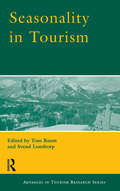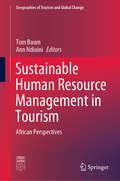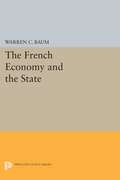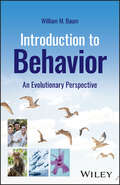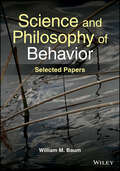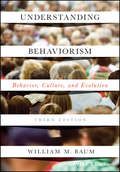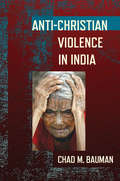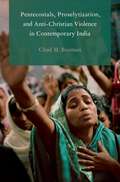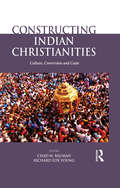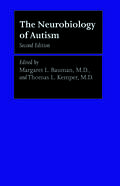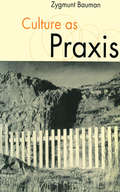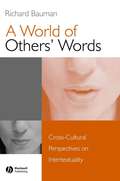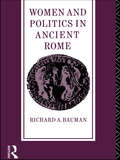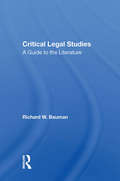- Table View
- List View
Seasonality in Tourism
by Tom Baum Svend LundtorpSeasonal variation in demand is a reality for most tourism destinations. This work provides a balanced overview of the evidence and issues relating to tourism seasonality using European, North American and Pacific Rim cases and research evidence.
Seasonality in Tourism (Advances In Tourism Research Ser.)
by Tom Baum Svend LundtropSeasonal variation in demand is a reality for most tourism destinations. This work provides a balanced overview of the evidence and issues relating to tourism seasonality using European, North American and Pacific Rim cases and research evidence.
Sustainable Human Resource Management in Tourism: African Perspectives (Geographies of Tourism and Global Change)
by Tom Baum Ann NdiuiniThis book addresses the application of sustainable HRM principles within tourism in the specific context of Africa, a neglected area of study. It draws on diverse aspects of HRM, from the micro- (individual) through the meso-level (organisational) to the macro-level (policy, governmental). It also reflects the diverse challenges facing a critical area within emerging African tourism, that of its workforce. The book is substantially research-based and provides a state-of-the-art picture of emergent studies in this area, drawing on case examples from a wide-range of African contexts. As such, it provides a comprehensive resource and starts discussion in an emergent research area.
French Economy and the State
by Warren C. BaumModern France is often referred to as the "sick man of Europe." With attention focused on the all-pervasive role of the state, Mr. Baum makes a revealing diagnosis. He provides a full view into the structure and performance of the French economy, dealing first with government efforts to solve certain general problems: reconstruction of the economic system, controlling cycles of inflation and recession, and closing the large gap in the balance of payments. After discussing the state's traditional role of public financier and its less orthodox role as entrepreneur in the large sector of the economy now under public ownership, he shows how the state acts as a regulator of private enterprise in industry and agriculture. Mr. Baum’s extensive use of original French source material and discussions with French officials in business and government make this book a unique contribution to understanding modern France.Originally published in 1958.The Princeton Legacy Library uses the latest print-on-demand technology to again make available previously out-of-print books from the distinguished backlist of Princeton University Press. These editions preserve the original texts of these important books while presenting them in durable paperback and hardcover editions. The goal of the Princeton Legacy Library is to vastly increase access to the rich scholarly heritage found in the thousands of books published by Princeton University Press since its founding in 1905.
Introduction to Behavior: An Evolutionary Perspective
by William M. BaumAn up-to-date approach to behavior analysis within the framework of evolutionary theory Introduction to Behavior is a contemporary textbook for students in behavior analysis and other behaviorally-oriented disciplines. Dispensing with outdated models of behavior and reinforcement, this book adopts a new conceptual framework for the understanding of behavior, human and nonhuman. It will help students at all levels, particularly students being trained in applied behavior analysis, offering an easily approachable and plausible framework that can inform both research and practice. Excellent for undergraduate and graduate students alike, as well as others interested in the field of behavior science, this book covers standard topics in behavior analysis from an up-to-date perspective. Readers will be introduced to a far more effective way of viewing behavior than the traditional reinforcement-based approach. Examine traditional concepts of behavior analysis from an evolutionary perspective Gain a concrete conceptual framework that can be used to guide research and practice in applied behavioral science Understand human and nonhuman behaviors, both in laboratory settings and in daily life, from an individual and a social perspective Build your knowledge of why people make the choices they make given particular environmental inputs Introduction to Behavior fills an important gap in available texts on behavior analysis, placing helpful behavioral concepts within a sound, evidence-based evolutionary framework.
Introduction to Behavior: An Evolutionary Perspective
by William M. BaumAn up-to-date approach to behavior analysis within the framework of evolutionary theory Introduction to Behavior is a contemporary textbook for students in behavior analysis and other behaviorally-oriented disciplines. Dispensing with outdated models of behavior and reinforcement, this book adopts a new conceptual framework for the understanding of behavior, human and nonhuman. It will help students at all levels, particularly students being trained in applied behavior analysis, offering an easily approachable and plausible framework that can inform both research and practice. Excellent for undergraduate and graduate students alike, as well as others interested in the field of behavior science, this book covers standard topics in behavior analysis from an up-to-date perspective. Readers will be introduced to a far more effective way of viewing behavior than the traditional reinforcement-based approach. Examine traditional concepts of behavior analysis from an evolutionary perspective Gain a concrete conceptual framework that can be used to guide research and practice in applied behavioral science Understand human and nonhuman behaviors, both in laboratory settings and in daily life, from an individual and a social perspective Build your knowledge of why people make the choices they make given particular environmental inputs Introduction to Behavior fills an important gap in available texts on behavior analysis, placing helpful behavioral concepts within a sound, evidence-based evolutionary framework.
Science and Philosophy of Behavior: Selected Papers
by William M. BaumRediscover the science and philosophy of behavior In Science and Philosophy of Behavior: Selected Papers, distinguished researcher W. M. Baum delivers an expansive collection of incisive papers setting out a new paradigm of thinking about behavior. The book offers only articles that put forward a philosophical and theoretical framework for an effective natural science of behavior. Quantitative analysis is largely avoided (except for a paper on, of all things, avoidance). Organized into three parts, the author explains the flow-like nature of behavior and its link to evolution, as well as descriptions of a pure form of behaviorism that correct some flaws in B.F. Skinner&’s seminal works. The book also links behaviorism to anthropology in its final section. Readers will also find: Fulsome descriptions of the molar nature of behavior and why the molecular view is misguided Re-imaginations of the concept of reinforcement, including considerations of allocation, induction, and contingency Explorations of the links between behavior analysis and Darwinian evolutionary processesAn essential critique—and reorganization—of behavior theory and philosophy, Science and Philosophy of Behavior: Selected Papers is a controversial, fascinating, and eye-opening journey through a half-century of transformational work in the field.
Science and Philosophy of Behavior: Selected Papers
by William M. BaumRediscover the science and philosophy of behavior In Science and Philosophy of Behavior: Selected Papers, distinguished researcher W. M. Baum delivers an expansive collection of incisive papers setting out a new paradigm of thinking about behavior. The book offers only articles that put forward a philosophical and theoretical framework for an effective natural science of behavior. Quantitative analysis is largely avoided (except for a paper on, of all things, avoidance). Organized into three parts, the author explains the flow-like nature of behavior and its link to evolution, as well as descriptions of a pure form of behaviorism that correct some flaws in B.F. Skinner&’s seminal works. The book also links behaviorism to anthropology in its final section. Readers will also find: Fulsome descriptions of the molar nature of behavior and why the molecular view is misguided Re-imaginations of the concept of reinforcement, including considerations of allocation, induction, and contingency Explorations of the links between behavior analysis and Darwinian evolutionary processesAn essential critique—and reorganization—of behavior theory and philosophy, Science and Philosophy of Behavior: Selected Papers is a controversial, fascinating, and eye-opening journey through a half-century of transformational work in the field.
Understanding Behaviorism: Behavior, Culture, and Evolution (Behavior Analysis And Society Ser.)
by William M. BaumUnderstanding Behaviorism is a classic textbook that explains the basis of behavior analysis and its application to human problems in a scholarly but accessible manner. Now in its third edition, the text has been substantially updated to include the latest developments over the last decade in behaviour analysis, evolutionary theory, and cultural evolution theory The only book available that explains behavior analysis and applies it to philosophical and practical problems, written by one of today’s best-known and most highly respected behaviorists Explores ancient concepts such as purpose, language, knowledge, and thought, as well as applying behavioural thinking to contemporary social issues like freedom, democracy, and culture Part of the new evolutionary perspective for understanding individual behavior in general and culture in particular – culminates with practical approaches to improving the lives of all humanity
Understanding Behaviorism: Behavior, Culture, and Evolution
by William M. BaumUnderstanding Behaviorism is a classic textbook that explains the basis of behavior analysis and its application to human problems in a scholarly but accessible manner. Now in its third edition, the text has been substantially updated to include the latest developments over the last decade in behaviour analysis, evolutionary theory, and cultural evolution theory The only book available that explains behavior analysis and applies it to philosophical and practical problems, written by one of today’s best-known and most highly respected behaviorists Explores ancient concepts such as purpose, language, knowledge, and thought, as well as applying behavioural thinking to contemporary social issues like freedom, democracy, and culture Part of the new evolutionary perspective for understanding individual behavior in general and culture in particular – culminates with practical approaches to improving the lives of all humanity
Current Management of Diabetic Retinopathy
by Caroline R. Baumal Jay S. DukerStay current with recent progress in the field of diabetic retinopathy management with this practical resource by Drs. Caroline R. Baumal and Jay S. Duker. Concise, highly illustrated coverage includes summaries of the latest evidence and expert guidance on the rationale for each therapeutic option.Features a wealth of information for ophthalmologists, retinal specialists, and trainees on current management of this increasingly common condition. Covers how to select the best course of action between drug, laser, or surgical treatment and how to achieve optimal results. Includes high-quality images that detail before and after treatment, including OCT. Consolidates today’s available information and guidance on diabetic retinopathy management into one convenient resource.
Anti-Christian Violence in India (Religion and Conflict)
by Chad M. BaumanDoes religion cause violent conflict, asks Chad M. Bauman, and if so, does it cause conflict more than other social identities? Through an extended history of Christian-Hindu relations, with particular attention to the 2007–2008 riots in Kandhamal, Odisha, Anti-Christian Violence in India examines religious violence and how it pertains to broader aspects of humanity. Is "religious" conflict sui generis, or is it merely one species of intergroup conflict? Why and how might violence become an attractive option for religious actors? What explains the increase in religious violence over the last twenty to thirty years?Integrating theories of anti-Christian violence focused on politics, economics, and proselytization, Anti-Christian Violence in India additionally weaves in recent theory about globalization and, in particular, the forms of resistance against Western secular modernity that globalization periodically helps to provoke. With such theories in mind, Bauman explores the nature of anti-Christian violence in India, contending that resistance to secular modernities is, in fact, an important but often overlooked reason behind Hindu attacks on Christians. Intensifying the widespread Hindu tendency to think of religion in ethnic rather than universal terms, the ideology of Hindutva, or "Hinduness," explicitly rejects both the secular privatization of religion and the separability of religions from the communities that incubate them. And so, with provocative and original analysis, Bauman questions whether anti-Christian violence in contemporary India is really about religion, in the narrowest sense, or rather a manifestation of broader concerns among some Hindus about the Western sociopolitical order with which they associate global Christianity.
PENT PROS & ANTI-CHRIST VIOL CONT IND C (Global Pentecostalism and Charismatic Christianity)
by Chad M. BaumanEvery year, there are several hundred attacks on India's Christians. These attacks are carried out by violent anti-minority activists, many of them provoked by what they perceive to be a Christian propensity for aggressive proselytization, or by rumored or real conversions to the faith. Pentecostals are disproportionately targeted. Drawing on extensive interviews, ethnographic work, and a vast scholarly literature on interreligious violence, Hindu nationalism, and Christianity in India, Chad Bauman examines this phenomenon. While some of the factors in the targeting of Pentecostals are obvious and expected-their relatively greater evangelical assertiveness, for instance-other significant factors are less acknowledged and more surprising: marginalization of Pentecostals by "mainstream" Christians, the social location of Pentecostal Christians, and transnational flows of missionary personnel, theories, and funds. A detailed analysis of Indian Christian history, contemporary Indian politics, Indian social and cultural characteristics, and Pentecostal belief and practice, this volume sheds important light on a troubling fact of contemporary Indian life.
Pentecostals, Proselytization, and Anti-Christian Violence in Contemporary India (Global Pentecostalism and Charismatic Christianity)
by Chad M. BaumanEvery year, there are several hundred attacks on India's Christians. These attacks are carried out by violent anti-minority activists, many of them provoked by what they perceive to be a Christian propensity for aggressive proselytization, or by rumored or real conversions to the faith. Pentecostals are disproportionately targeted. Drawing on extensive interviews, ethnographic work, and a vast scholarly literature on interreligious violence, Hindu nationalism, and Christianity in India, Chad Bauman examines this phenomenon. While some of the factors in the targeting of Pentecostals are obvious and expected-their relatively greater evangelical assertiveness, for instance-other significant factors are less acknowledged and more surprising: marginalization of Pentecostals by "mainstream" Christians, the social location of Pentecostal Christians, and transnational flows of missionary personnel, theories, and funds. A detailed analysis of Indian Christian history, contemporary Indian politics, Indian social and cultural characteristics, and Pentecostal belief and practice, this volume sheds important light on a troubling fact of contemporary Indian life.
Constructing Indian Christianities: Culture, Conversion and Caste
by Chad M. Bauman Richard Fox YoungThis volume offers insights into the current ‘public-square’ debates on Indian Christianity. Drawing on ethnographic fieldwork as well as rigorous analyses, it discusses the myriad histories of Christianity in India, its everyday practice and contestations and the process of its indigenisation. It addresses complex and pertinent themes such as Dalit Indian Christianity, diasporic nationalism and conversion. The work will interest scholars and researchers of religious studies, Dalit and subaltern studies, modern Indian history, and politics.
Constructing Indian Christianities: Culture, Conversion and Caste
by Chad M. Bauman Richard Fox YoungThis volume offers insights into the current ‘public-square’ debates on Indian Christianity. Drawing on ethnographic fieldwork as well as rigorous analyses, it discusses the myriad histories of Christianity in India, its everyday practice and contestations and the process of its indigenisation. It addresses complex and pertinent themes such as Dalit Indian Christianity, diasporic nationalism and conversion. The work will interest scholars and researchers of religious studies, Dalit and subaltern studies, modern Indian history, and politics.
The Neurobiology of Autism (The Johns Hopkins Series in Psychiatry and Neuroscience)
by Margaret L. BaumanIn the decade since the first edition of The Neurobiology of Autism was published, research has revealed valuable new information about the nature and origins of autism, including genetics and abnormalities in such neurotransmitters as acetylcholine and serotonin. For this long-anticipated new edition, neurologists Margaret L. Bauman and Thomas L. Kemper bring together leading researchers and clinicians to present the most current scientific knowledge and theories about autism. The contributors cover genetics, imaging studies, physiology, neuroanatomy and neurochemistry, immunology, brain function, the epidemiology of the disease, and related disorders. Thoroughly updated, The Neurobiology of Autism remains the best single-volume work on the wide array of research being conducted into the causes, characteristics, and treatment of autism.Contributors: George M. Anderson, Yale Child Study Center; Tara L. Arndt, University of Rochester Medical Center (URMC); Trang Au, University of Massachusetts Medical School (UMMC); Jocelyne Bachevalier, University of Texas Health Science Center; Irina N. Bespalova, Seaver Autism Research Center, Mt. Sinai School of Medicine (SARC); Gene J. Blatt, Boston University School of Medicine (BUSM); Susan E. Bryson, IWK Health Centre–Dalhousie University; Timothy M. Buie, Massachusetts General Hospital (MGH); Joseph D. Buxbaum, SARC; Kathryn M. Carbone, The Johns Hopkins University School of Medicine (JHUSM); Diane C. Chugani, Wayne State University; Daniel F. Connor, UMMC; Edwin H. Cook, Jr., University of Chicago; S. Hossein Fatemi, University of Minnesota Medical School; Susan E. Folstein, Tufts University School of Medicine; Eric Fombonne, McGill University; Randi Jenssen Hagerman, UC Davis Medical Center; Elizabeth Petri Henske, Fox Chase Cancer Center, Philadelphia; Jeannette J. A. Holden, Queen's University; Ronald J. Killiany, BUSM; Omanand Koul, UMMC; Mandy Lee, Newcastle General Hospital, U.K.; Xudong Liu, Queen's University; Tara L. Moore, BUSM; Mark B. Moss, BUSM; Karin B. Nelson, National Institute of Neurological Disorders and Stroke; Phillip G. Nelson, National Institute of Child Health and Human Development; Elaine Perry, Newcastle General Hospital; Jonathan Pevsner, JHUSM; Mikhail V. Pletnikov, JHUSM; Stephen W. Porges, University of Illinois at Chicago; Lucio Rehbein, Universidad de la Frontera, Chile; Jennifer Reichert, SARC; Patricia M. Rodier, URMC; Beth Rosen-Sheidley, MGH; Susan L. Smalley, UCLA Neuropsychiatric Research Institute; Ronald J. Steingard, UMMC; Helen Tager-Flusberg, BUSM; Gary L. Wenk, University of Arizona; Andrew W. Zimmerman, JHUSM
Jewish American Chronology: Chronologies of the American Mosaic
by Mark K. BaumanThis comprehensive and analytical history of American Jews and Judaism from the Colonial Era to the present explores the impact of America on Jews and of Jews on America.Covering more than four centuries from the Colonial Era forward, Jewish American Chronology offers an introduction to the history of American Jews and Judaism, using individual examples, personality profiles, and illustrations to bring fundamental patterns and major themes to life. Arranged chronologically, the entries illustrate how a variety of different Jewish groups and individuals have adapted to America, both changing in accordance with time and place and retaining tradition and culture, even as they became thoroughly American.Readers will learn how Jews have created community and institutions, confronted anti-Semitism, and interacted among themselves and with other groups. They will read about immigration, migration, and socioeconomic mobility. And they will discover how Jews have filled critical economic niches, contributed disproportionately in a variety of endeavors, and changed over time and in reaction to circumstances. In this wide-ranging work, Jewish Americans are depicted in a balanced and accurate manner, describing Nobel Prize winners and standout economic success stories as well as those who achieved fame and notoriety in other ways.
Culture as Praxis
by Professor Zygmunt BaumanIn this major work, Zygmunt Bauman seeks to classify the meanings of culture. He distinguishes between culture as a concept, culture as a structure and culture as praxis and analyzes the different ways in which culture has been used in each of these settings. For Bauman, culture is a living, changing aspect of human interaction which must be understood and studied as a universal of human life. At the heart of his approach is the proposition that culture is inherently ambivalent. With a major new introduction to this new edition, this classic work emerges as a crucial link in the development of Bauman's thought. By his own admission, it was the first of his books to grope towards a new kind of social theory, in contrast to the false certainties and gross theorems that dominated much of the post-war period. This is Bauman at his best, at his most subtle and his most searching.
Culture as Praxis (PDF)
by Professor Zygmunt BaumanIn this major work, Zygmunt Bauman seeks to classify the meanings of culture. He distinguishes between culture as a concept, culture as a structure and culture as praxis and analyzes the different ways in which culture has been used in each of these settings. For Bauman, culture is a living, changing aspect of human interaction which must be understood and studied as a universal of human life. At the heart of his approach is the proposition that culture is inherently ambivalent. With a major new introduction to this new edition, this classic work emerges as a crucial link in the development of Bauman's thought. By his own admission, it was the first of his books to grope towards a new kind of social theory, in contrast to the false certainties and gross theorems that dominated much of the post-war period. This is Bauman at his best, at his most subtle and his most searching.
A World of Others' Words: Cross-Cultural Perspectives on Intertextuality
by Richard BaumanDrawing on his work in Iceland, Ireland, Scotland, North America, Ghana, and Fiji, linguistic anthropologist and folklorist Richard Bauman presents a series of ethnographic case studies that offer a sparkling look at intertextuality as communicative practice. A fascinating perspective on intertextuality: the idea that written and spoken texts speak to one another, e.g. through genre or allusions. Presents a series of ethnographic case studies to illustrate the topic. Draws on a broad range of oral performances and literary records from across the world. The author’s introduction sets a framework for the analysis of genre, perform and intertextuality. Shows how performers blend genres, e.g., telling stories about riddles or legends about magical verses, or constructing sales pitches.
Women and Politics in Ancient Rome
by Richard A. BaumanFirst published in 1994. Routledge is an imprint of Taylor & Francis, an informa company.
Women and Politics in Ancient Rome
by Richard A. BaumanFirst published in 1994. Routledge is an imprint of Taylor & Francis, an informa company.
Critical Legal Studies: A Guide To The Literature
by Richard W BaumanContemporary legal thought has been powerfully influenced by Critical Legal Studies, a school of legal scholars whose work has sustained a continuing radical critique of established legal doctrines. In this essential reference work, Richard Bauman presents the most thorough, up-to-date guide available for this essential literature. In addition to providing the basic bibliographic information, Bauman offers a set of effective introductions to contextualize and explain the work being surveyed. He has created a fundamental handbook not only for the law but also for politics and radical thought.
Critical Legal Studies: A Guide To The Literature
by Richard W BaumanContemporary legal thought has been powerfully influenced by Critical Legal Studies, a school of legal scholars whose work has sustained a continuing radical critique of established legal doctrines. In this essential reference work, Richard Bauman presents the most thorough, up-to-date guide available for this essential literature. In addition to providing the basic bibliographic information, Bauman offers a set of effective introductions to contextualize and explain the work being surveyed. He has created a fundamental handbook not only for the law but also for politics and radical thought.
